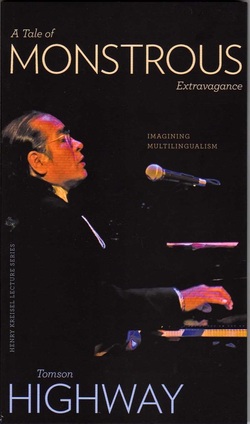
The cover of this slim book prints “Monstrous” and “Highway” at the top and bottom in the same 44-point sans typeface, in contrast to the 12-point and 9-point non-sans of the remaining text. Monstrous Highway. In the cover photograph Highway is striking a head-back Elton John pose while singing to his own piano accompaniment. A similar vocal-piano photo of him appears on page 3 – perhaps a metaphorical substitution for one of him speaking.
The text is Highway’s lecture in the University of Alberta’s Henry Kreisel Lecture series in March of 2014 – a lecture that was, as the photographs suggest, also a performance. The typographers have worked with some success to enliven the text symbolically with contrasting fonts and music symbols, and to present its delivery as – and as it deserved to be – a career-celebrating moment.
The lecture itself is essentially a narrative of Highway’s life from birth in a tent pitched by his Cree parents on a Nunuvut snowbank some hundred kilometres north of their home Brochet, Manitoba, to his current career as an internationally productive playwright, novelist, and entertainer who along the way has become fluent in possibly seven languages (eight, he implies, if one includes that of music notation). His performance of the lecture – mostly in English but also in Cree and French – makes this journey seem amusing, pleasant, enriching, and paradoxically both unlikely and easy. Highway builds the unlikeliness of his story on the cultural
A mostly unspoken/unwritten element in his text is the contrastingly desperate condition of most of Canada’s aboriginal cultures – their current high levels of internal violence, high suicide rates, high rates of criminal convictions, low levels of educational attainment, high rates of unemployment, and the epidemic abuse and murder, both outside and inside aboriginal communities, of aboriginal women. None of these things – the subject in May 2014 of a United Nations report that characterized them as constituting “a crisis among [Canadian] aboriginal communities in terms of their basic necessities” – appear to have been a part of Highway’s own life, a fact which throughout the lecture adds to the humour he is able to create by his story’s unlikely evasion of the stereotypes his educated audience is certain to have encountered about similar aboriginal subjects. The book cover’s “monstrous highway” becomes both an hilarious and troublingly unlikely road away from aboriginal failure and hopelessness.
Only once in the book does Highway appear unhappy about this. About half way through his entertaining celebration of his how a pastoral northern aboriginal multilingual childhood led to his being able to recommend Budapest, Santiago, and Tokyo as each a “fabulous city” (35-6), he recalls for a short paragraph the savage 1971 murder in Manitoba of the young Cree woman Helen Betty Osborne and the serial killings, mostly of aboriginal sex workers, committed in British Columbia more recently by Robert Pickton (17). But the paragraph segues quickly back to Highway’s personal avoidance of stereotypes: “At age almost seven I left the paradise that is northern Manitoba to go to boarding [residential] school. That’s what I call it because, for me, it was a positive experience.”
Because of the practically Jesuit-style regimented education that I got at that school,
for one thing, I enjoy today a thriving international career that takes me, regular as
clockwork, to all six inhabited continents – I just got back from India and I’m on my
way to Brazil. Goodbye -30. (19)
Goodbye much more than that. I’m left thinking less of Highway’s enviable travels than of how it is to Canada’s shame that his story can seem so extravagantly unlikely. Pickton’s victims might have also enjoyed visits to “fabulous” Budapest, Santiago, or Tokyo. I’m left wondering also what Highway thinks of this contrast between his own formative experiences and the effect which similar experiences appear to have had on others. What can we learn from a remarkable individual about a systemic disaster by which he claims to have been only positively touched? Should there have been more Jesuits? Could multilingual education succeed as a national social policy?
FD
 RSS Feed
RSS Feed